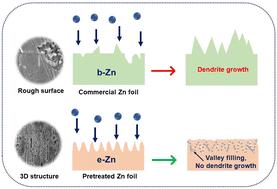当前位置:
X-MOL 学术
›
J. Mater. Chem. A
›
论文详情
Our official English website, www.x-mol.net, welcomes your
feedback! (Note: you will need to create a separate account there.)
Beyond conventional: unveiling the impact of Zn anode pretreatment in aqueous zinc-ion batteries
Journal of Materials Chemistry A ( IF 10.7 ) Pub Date : 2024-09-18 , DOI: 10.1039/d4ta03160a Sanna Gull, Chi-Yu Lai, Wen-Hsuan Lu, Bushra Rehman, Wan-Ju Chiu, Han-Yi Chen
Journal of Materials Chemistry A ( IF 10.7 ) Pub Date : 2024-09-18 , DOI: 10.1039/d4ta03160a Sanna Gull, Chi-Yu Lai, Wen-Hsuan Lu, Bushra Rehman, Wan-Ju Chiu, Han-Yi Chen

|
Despite the simplicity and widespread use of conventional (untreated) Zn foil as a benchmark, conventional Zn foil continues to be the most common anode material in the research of zinc-ion batteries (ZIBs). However, there has been little focus on the inherent structure of the zinc foil itself. The traditional Zn anode has uneven rough surfaces that can lead to nonuniform charge distribution and hinder nucleation, thereby triggering the “tip effect” that can induce the formation of adverse dendrites. In this study, the conventional Zn foil was examined using simple pretreatments such as mechanical polishing and chemical etching that have the potential to substantially improve the electrochemical properties. Compared with bare Zn (b-Zn) and polished Zn (p-Zn), chemically etched Zn (e-Zn) sustained a remarkable life cycle of up to 5000 cycles with ∼71% cycling retention at a high current density of 5 A g−1 using V2O5·nH2O as a cathode material. Besides, the e-Zn‖e-Zn symmetric cell exhibited excellent cycling stability over 300 cycles at a high current density of 10 mA cm−2 with better inhibiting hydrogen production during Zn stripping/plating. Moreover, advanced characterizations such as in situ transmission X-ray microscopy (TXM) and ex situ atomic force microscopy (AFM) have been employed to gain insight into the early stages of Zn dendrite formation on Zn foils in mild acidic aqueous electrolytes during the plating/stripping processes. This superior performance of the e-Zn is attributed to its unique 3D structure that effectively accommodates Zn dendrites, as confirmed by XRD and EBSD analyses, which reveal Zn deposition along the (002) plane with lower surface energy as compared with other planes. This approach provides a straightforward and industrially scalable method for expanding ZIB utilization.
中文翻译:

超越传统:揭示锌阳极预处理对水性锌离子电池的影响
尽管传统(未经处理的)锌箔简单且广泛使用作为基准,但传统锌箔仍然是锌离子电池(ZIB)研究中最常见的负极材料。然而,人们很少关注锌箔本身的固有结构。传统的锌阳极具有不均匀的粗糙表面,会导致电荷分布不均匀并阻碍成核,从而引发“尖端效应”,从而诱发不利枝晶的形成。在这项研究中,使用简单的预处理(例如机械抛光和化学蚀刻)对传统的锌箔进行了检查,这些预处理有可能显着提高电化学性能。与裸露的锌 (b-Zn) 和抛光的锌 (p-Zn) 相比,化学蚀刻的锌 (e-Zn) 在 5 A 的高电流密度下维持了高达 5000 次循环的卓越生命周期,循环保持率约为 71% g -1使用V 2 O 5 · n H 2 O作为正极材料。此外,e-Zn‖e-Zn对称电池在10 mA cm -2的高电流密度下表现出超过300次循环的优异循环稳定性,并且更好地抑制Zn剥离/电镀过程中的氢气产生。此外,还采用原位透射 X 射线显微镜 (TXM) 和异位原子力显微镜 (AFM) 等先进表征技术来深入了解电镀过程中弱酸性水性电解质中锌箔上锌枝晶形成的早期阶段/剥离过程。 e-Zn 的这种优越性能归因于其独特的 3D 结构,该结构有效地容纳了 Zn 枝晶,这一点经 XRD 和 EBSD 分析证实,表明与其他平面相比,Zn 沿着 (002) 平面沉积,具有较低的表面能。这种方法为扩大 ZIB 利用率提供了一种简单且工业上可扩展的方法。
更新日期:2024-09-21
中文翻译:

超越传统:揭示锌阳极预处理对水性锌离子电池的影响
尽管传统(未经处理的)锌箔简单且广泛使用作为基准,但传统锌箔仍然是锌离子电池(ZIB)研究中最常见的负极材料。然而,人们很少关注锌箔本身的固有结构。传统的锌阳极具有不均匀的粗糙表面,会导致电荷分布不均匀并阻碍成核,从而引发“尖端效应”,从而诱发不利枝晶的形成。在这项研究中,使用简单的预处理(例如机械抛光和化学蚀刻)对传统的锌箔进行了检查,这些预处理有可能显着提高电化学性能。与裸露的锌 (b-Zn) 和抛光的锌 (p-Zn) 相比,化学蚀刻的锌 (e-Zn) 在 5 A 的高电流密度下维持了高达 5000 次循环的卓越生命周期,循环保持率约为 71% g -1使用V 2 O 5 · n H 2 O作为正极材料。此外,e-Zn‖e-Zn对称电池在10 mA cm -2的高电流密度下表现出超过300次循环的优异循环稳定性,并且更好地抑制Zn剥离/电镀过程中的氢气产生。此外,还采用原位透射 X 射线显微镜 (TXM) 和异位原子力显微镜 (AFM) 等先进表征技术来深入了解电镀过程中弱酸性水性电解质中锌箔上锌枝晶形成的早期阶段/剥离过程。 e-Zn 的这种优越性能归因于其独特的 3D 结构,该结构有效地容纳了 Zn 枝晶,这一点经 XRD 和 EBSD 分析证实,表明与其他平面相比,Zn 沿着 (002) 平面沉积,具有较低的表面能。这种方法为扩大 ZIB 利用率提供了一种简单且工业上可扩展的方法。











































 京公网安备 11010802027423号
京公网安备 11010802027423号